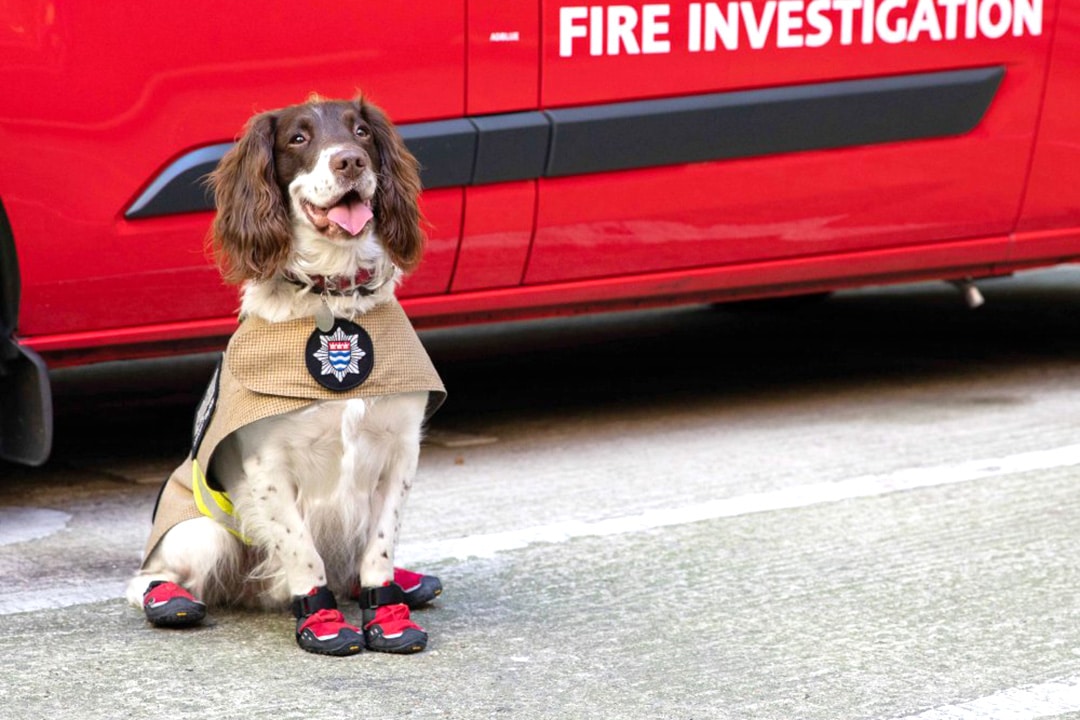Accelerant Detection Canine (ADC) UK
Fire Dogs
There are very few of them. Most folks don’t even know that they exist. They are highly trained, but if you were to pass one in the street without their very special uniform, they are unrecognizable. They can smell substances that are undetectable to the human nose. Despite their anonymity, they are the scourge of the arsonist. Their specialist skill is even responsible for the identification and conviction of murderers. They are the Accelerant Detection Canines, also known as Fire Investigation Dogs but more affectionately referred to as The Fire Dogs.
In order to establish the causes of a fire one of the most important people will be the forensic expert who will analyse the debris that is presented to them by the fire investigators. Long before the scientists get close or the investigators can deliver the samples, the chain is started by the fire brigades’ remarkably talented canines.
So who and what are they, what do they do, and how do they do it?
When a fire occurs, it is basically intentional or accidental.
Let’s start with the accidental ones: the unattended chip pan, the carelessly left cigarette, and the electrical fault. These are generally identified fairly quickly by experienced fire investigators and confirmed by the dog. This is the other side of the fire dog’s job, as not only do they assist in identifying arson but also indicate when no crime has been committed. Before going further, we need to establish their credentials.
Credentials
Two breeds favoured but not exclusive are the Labrador and the Springer Spaniel, which are acquired from breeders of working gundogs.
The puppies are specially chosen and will show an aptitude for work very early.
Their training will last 6-8 months and will be evaluated annually
They can identify up to 30 different accelerants.
They live with their handler, and generally, when retirement arrives, most spend it with the same handler.
They retire at 6-8 years of age, however, if they show that they are still able to continue past the age then they stay working.
When working the wear a high visibility jacket and special rubber boots to protect their feet from glass and sharp objects. They are never sent in until the fire is completely extinguished.
Fires started intentionally are mostly started by using an accelerant. Examples are paraffin, petrol, and cigarette lighter fuel. The dog indicates exactly where the fire started, usually by staring at the point where the fire started. The dog is rewarded, and a sample of the debris is sent to the laboratory, where the scientists will confirm whether the dog’s nose is correct. (It usually is!!)
We cannot make machines that are as reliable as a dog’s nose. What is really extraordinary is that the dog has the ability to differentiate between hydrocarbons that naturally occur when a fire burns and the hydrocarbons emitted by a fire deliberately started by an arsonist.
Like all working dogs, the relationship between dog and handler is paramount. It is a bond that is unique. Having experienced this myself more than once, I can confirm that the bond is such that an almost telepathic relationship develops. It reaches the point where commands almost become unnecessary. I can also confirm that watching your working dog performing a difficult task without instructions, along with their ability to ignore distractions, is awesome. As I reminisce, I remember Zircon and Zena, with whom I was privileged to have that amazing bond.
NOTABLE DOGS
Reqs
In 2023, Reqs, a black Labrador, retired. He remains the longest-serving fire detection dog to date, having served for 11 years after attending over 500 fires. In an exemplary career, he has been involved in a number of high-profile cases, including murder, attempted murder, arson and false imprisonment.
He was rewarded with a lifetime service medal and is the 42nd dog to receive the PDSA Order of Merit awarded for outstanding devotion to owner or wider society.
Simba
In 2018, 8 engines and some 60 firefighters attended a fire blazing at a residential address in Woolwich. Sadly a lady lost her life, the fire was considered suspicious and the brigade looked to their dog.
Enter Simba a two year old Springer Spaniel.
Even when he was 3 metres away from the front door of the house, he indicated that there was evidence of an accelerant and was able to show where the fire started. He did this instantly, saving the investigators countless hours and ensuring that the crime scene was stabilised and preventing any loss of evidence. The evidence showed that undoubtedly the fire was arson, and the matter was passed to the police. After a thorough investigation, the report was presented to the Crown Prosecution Service which brought charges against those considered culpable of the offence.
The result was that two men received custodial sentences of life imprisonment with a minimum tariff of 31 & 32 years, respectively.
Digby
I know he is not a fire dog, but I couldn’t resist bringing this to you; the Devon and Somerset Fire and Rescue Service employ Digby, a Cockerpoo, as a therapy dog assisting firefighters who are constantly exposed to trauma.
In 2021, he was taken by a fire crew to assist in stopping a potential suicide by a distressed lady intent on taking her own life. She was planning to jump off a bridge over the M5 motorway, but she took one look at Digby, smiled, and changed her mind!!
“When the man waked up, he said, “What is Wild Dog doing here?” The woman answered, “His name is not Wild Dog anymore but First Friend,” because he will be our friend always and always and always.”
Rudyard Kipling









